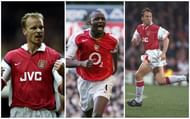"It's not the salary that's a problem; it's just the image rights that needed a little perking.”
David Beckham made this comment about image rights all the way back in 2002, in the middle of contract negotiations with Manchester United.
One of the major issues involved in Cristiano Ronaldo’s contract renegotiation with Real Madrid in 2013 was the discussions of image rights, with Madrid finally ceding even more control of the rights to the Portuguese superstar. Under his initial contract with Madrid, Ronaldo owned 60% of his image rights with the other 40% going to Real Madrid.
However, in June 2015, Ronaldo signed a six-year contract with Mint Media, a Hong Kong-based firm owned by Singaporean billionaire Peter Lim. According to the contract, Mint Media owns all of Ronaldo's image rights excluding whatever relates to Real Madrid.
The contract he subsequently signed with Real Madrid (which ties him to the club until 2018) saw him claim an even greater portion of that revenue stream and increase his earning potential even further.
So what exactly are image rights?
In a nutshell, ‘Image Rights’ are the proprietary rights that an individual has in the image of himself or herself, and the other unique characteristics associated with their personality (such as their signature).
Evert person has a right to own, control and administer his or her own image. They are the equivalents of trademark protection for a logo, or copyright for a work of art.
Image rights provide their holders protection against unauthorised persons claiming ownership or endorsement by the holder without their permission. Persons who are constantly highlighted by the media (such as athletes, actors, and musicians, for example) can derive huge financial benefits from intelligent leveraging of these rights.
The nature of image rights is such that only the most famous players in the world can reasonably use them as a large source of income. For this tier of players, the wages they earn from a club can be substantially less than the money they make from commercial sources.
For example, Cristiano Ronaldo’s wages annually are in the range of €17 million, while his income from commercial earnings is estimated to be around €23 million annually.
When a transfer is held up due to negotiation of “personal terms”, the arrangement regarding image rights is almost certainly one of the “terms” that are being discussed.
Image rights payments are likely to be renegotiated more often than player contracts, due to the fluctuating nature of the use of a player in a club’s promotional material.
Agents might negotiate with the club based on the total commercial revenue and the amount of material that a player featured in. A portion of the total revenue might then be negotiated to be paid back to the player.
History of players’ image rights in England
The formation of the Premier League in 1992 and the subsequent explosion in funding for the sport led to the first million-pound sponsorship deals for football players, as corporations looked for novel ways to promote their products. This provided avenues for players to substantially increase their incomes.
The flipside of this arrangement, however, is that sponsorship contracts can be terminated if the players engage in behaviour that the sponsor deems unsuitable. Eric Cantona had a major sponsorship deal suspended after he kicked a spectator, and similar treatment was given to Zinedine Zidane after his infamous head-butt on Marco Materazzi in the 2006 World Cup final.
The influx of top international players in the 1990s led to an increase in the popularity of image rights contracts. Many of these players had them at their previous clubs, and agents who were aware of the value of this structure began to push for them for all of their clients.

The first group of players to negotiate these types of deals in England were Dennis Bergkamp, Patrick Viera and David Platt, who was an Englishman plying his trade in Italy before moving to Arsenal.
The system worked something like this - The players’ contractually guaranteed salary would be paid in England with full taxes. At the same time, a flat fee for image rights would be paid by the club to a separate company set up by the player to which the rights had been assigned.
Foreign players could set the company up in a jurisdiction that had low tax rates, avoiding the tax structure of the UK. Wages provided enough money for the player’s day-to-day expenses, so the image rights company was to be used as a fund for the future. If the money was brought back into the UK, then they would have to pay additional income tax on the sum as well as the corporate tax.
When Bergkamp and Platt both moved to Arsenal from Inter Milan and Sampdoria respectively in 1995, both of them already had their own existing image rights companies and contracts. Arsenal entered into playing contracts with both players and image-rights contracts with the companies so as to secure the players' commitment to the clubs commercial projects.
This new arrangement raised eyebrows among the tax authorities, who felt that this was merely a method of structuring payments so as to avoid taxation. Bergkamp at the time was earning £2 million a year in wages, along with £1.5 million in image rights.
The argument that would have to be successfully presented was that his rights were actually worth £1.5 million and this wasn’t just a total wage of £3.5 million that was divided in a more tax efficient way. Bergkamp won that case, and it is believed that was a major factor in increasing the number of foreign players that arrived in England.
Based on the ruling in this case, foreign players were now able to split up to half of their income as image rights and pay much less tax on it (28% as opposed to nearly 50%).
British players were not nearly as lucky, being liable to full taxation rates regardless of the entity that the image rights payments were made to. The only way to avoid this would be to register an entity offshore (i.e. not in the UK) and not access that money until a player was no longer considered a British resident for tax purposes.
Image rights vs. team rights
One of the most famous images of the modern Premier League era is the one where Sergio Aguero celebrates THAT goal against Queens Park Rangers, the one that brought the title back to the Eastlands after 44 years.

If City were to use this photo for any promotional activity, or sell it as a poster, they would have to make image rights payments to Aguero. However, this does not apply to a team picture.
The current rule is that any image with three or more players from the squad constitutes a team picture. There are also rules regarding the use of “fringe” players to qualify as a team image.
This is one of the reasons that kit launches have a multitude of players, as opposed to just the “stars” of the team. The choice of players for such events is heavily impacted by image rights issues. This extends to organisations such as the Premier League as well.
The Premier League owns the rights to teams and matches, but not to individual players. This is why promotional material for the League uses many players.
For example, the introduction video to the 2013-14 Premier League season featured more than a dozen players from more than 12 teams, each appearing for not more than a second.
Expansion of image rights
As clubs become more and more reliant on commercial income and matchday revenue compromising and less of a club’s total income, clubs seek to find new methods of increasing their earnings. Real Madrid was among the first clubs to recognise the value of player image rights, and this understanding was one of the major factors behind the Galacticos project.
Florentino Perez, in his earlier stint at the club, instituted a system where image rights would be shared equally between club and player. The argument behind this was that the commercial value of a player would be heavily influenced by the fact that he plays for Real Madrid.
The issue over image rights almost scuppered David Beckham’s move to Los Blancos, before both parties were able to reach a suitable agreement on the matter. In the end, it worked out well for both parties.
Madrid saw a 137% rise in merchandising revenue alone during Beckham’s four-year stint at the club, and Beckham’s brand benefitted immensely from exposure to the Spanish-speaking markets that Real Madrid dominates. Beckham’s contract with the LA Galaxy had him splitting image rights in an 80-20 ratio with the club.
The first (and so far only time) Madrid have broken the 50-50 agreement was for Cristiano Ronaldo when he first moved in 2009. Ronaldo was able to negotiate a 60-40 arrangement, which probably was only possible due to his fantastic season the year before.
Image rights are becoming increasingly commonplace, and clubs often find themselves having to deal with such structures more and more frequently. Before a player sets up an image rights company however, the player must have an image or brand that would have commercial appeal to sponsors.
Once the company has been established, any prospective buying club that wishes to use the image for commercial activities would have to strike an agreement with the company.
Some players even establish two companies; one to manage rights in the UK, and another to manage rights in other jurisdictions. This allows them to keep income from non-UK deals out of the purview of the British taxman.
As the money floods into the modern sport and commercial agreements become bigger and more complex, there are a multitude of transactions that take place now while satisfying image rights payments. These can include payments from sponsors to players, sponsors to clubs, clubs to players, players to club, offshore structures, tax rates, different legal jurisdictions.
There can also be issues when the player and club have different sponsors.
At a fundamental level, image rights agreements are simply the remuneration paid to a player for the use of his image. The intertwining of commercial rights, tax issues, and sponsorships however, have made it a rather convoluted structure, but one that cannot be ignored by either clubs or players due to the financial significance they carry.
With the money continuing to pour in, and the game increasing its audience and market around the world, image rights will be a major consideration for both clubs and players across the world.

